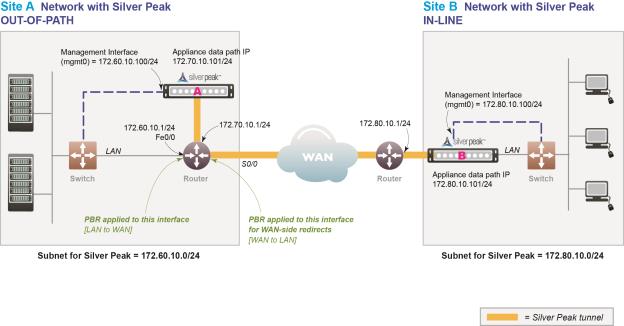This scenario deploys Site B in-line and the Site A network out-of-path using an available spare router port. Policy-Based Routing (PBR) is configured on interfaces of Site A’s router to redirect traffic destined for the WAN to the Silver Peak appliance.
In this example, the Silver Peak appliance optimizes traffic to/from 172.60.10.0/24 and 172.80.10.0/24.
|
|||||
|
|||||
Fail-safe behavior should always be tested before production deployment by ensuring that traffic continues to flow in each of the following cases:
|
1
|
With the appliance in bypass state
|
|
2
|
With the appliance powered off
|
|
Gather all the IP addresses needed for setup
|
|||
|
Install the appliance into the network
|
Physical appliance: Connect the Site A appliance to the Site A router, and insert the Site B appliance between its WAN edge router and the Ethernet switch. Verify connectivity, connect power, and verify LEDs.
Virtual appliance: Configure the hypervisor, with the required interfaces.
|
||
|
From a web browser, access and use the Initial Configuration Wizard to configure the appliance in Router mode.
|
|||
|
Access the router’s command line interface, and configure the router for policy-based routing.
|
|||
|
Use the Appliance Manager to configure Site A’s Silver Peak appliance.
|
|||
|
Use the Initial Configuration Wizard to configure Site B’s appliance in Bridge mode.
|
|
|
|
n
|
Speed and duplex for all interfaces are left at the default: auto-negotiation.
|
|
n
|
Although it isn’t a requirement, it’s considered a best practice to use different subnets for mgmt0 and the Appliance IP.
|
|
mgmt0 IP Address / Mask1
|
||
|
LAN Next-hop IP Address (optional) 2
|
|
|
|
|

